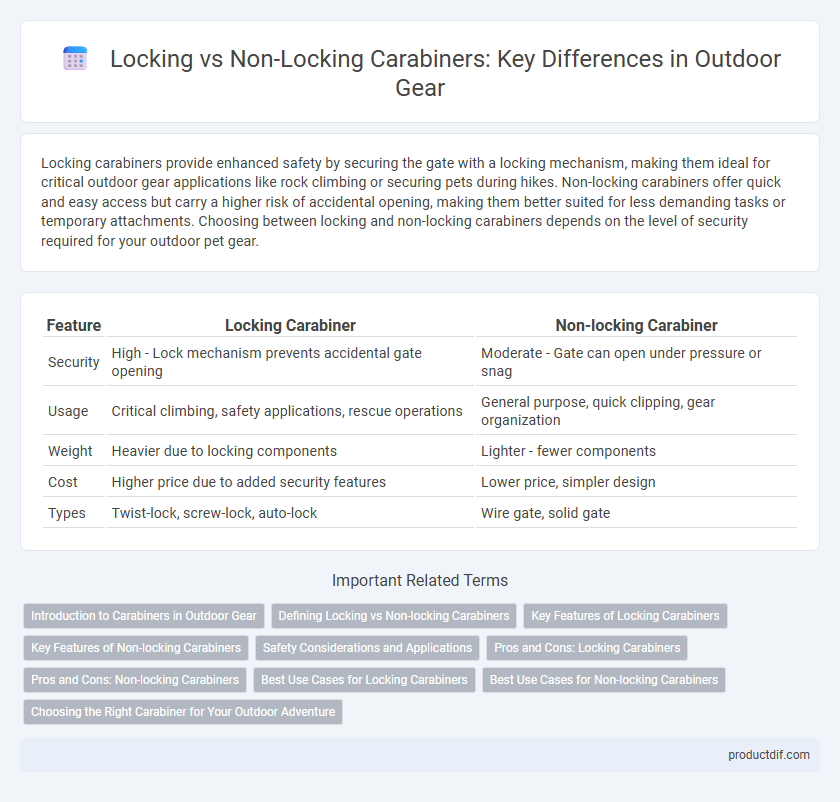Locking carabiners provide enhanced safety by securing the gate with a locking mechanism, making them ideal for critical outdoor gear applications like rock climbing or securing pets during hikes. Non-locking carabiners offer quick and easy access but carry a higher risk of accidental opening, making them better suited for less demanding tasks or temporary attachments. Choosing between locking and non-locking carabiners depends on the level of security required for your outdoor pet gear.
Table of Comparison
| Feature | Locking Carabiner | Non-locking Carabiner |
|---|---|---|
| Security | High - Lock mechanism prevents accidental gate opening | Moderate - Gate can open under pressure or snag |
| Usage | Critical climbing, safety applications, rescue operations | General purpose, quick clipping, gear organization |
| Weight | Heavier due to locking components | Lighter - fewer components |
| Cost | Higher price due to added security features | Lower price, simpler design |
| Types | Twist-lock, screw-lock, auto-lock | Wire gate, solid gate |
Introduction to Carabiners in Outdoor Gear
Locking carabiners provide enhanced security by featuring a mechanism that prevents accidental gate opening, making them essential for critical safety applications in climbing and rescue operations. Non-locking carabiners offer quicker, lighter connections suitable for gear organization and general outdoor activities where high load security is less critical. Selecting the appropriate carabiner depends on the specific outdoor gear requirements, balancing ease of use with safety and load stability.
Defining Locking vs Non-locking Carabiners
Locking carabiners feature a mechanism that secures the gate, preventing accidental opening during critical outdoor activities such as climbing or rappelling. Non-locking carabiners lack this safety feature and are typically used for gear organization or quick attachments where load security is less critical. Understanding the difference between locking and non-locking carabiners is essential for choosing the right equipment based on safety requirements and intended use.
Key Features of Locking Carabiners
Locking carabiners provide enhanced safety through a secure locking mechanism that prevents accidental gate opening, making them ideal for critical climbing and rescue operations. They feature robust construction with screw-lock, twist-lock, or auto-lock gates to ensure reliable load-bearing capacity and increased durability under dynamic forces. These carabiners are essential for securing harnesses, belay systems, and anchor points, offering peace of mind in high-risk outdoor activities.
Key Features of Non-locking Carabiners
Non-locking carabiners feature a lightweight, simple design with a spring-loaded gate that allows for quick clipping and unclipping, making them ideal for fast and frequent connections in climbing and outdoor activities. They offer high strength-to-weight ratios but lack the safety assurance provided by locking mechanisms, making them best suited for non-critical applications like gear organization or quickdraws. Their versatility and ease of use make them a popular choice for climbers seeking efficiency over maximum security in everyday outdoor gear setups.
Safety Considerations and Applications
Locking carabiners provide enhanced safety by securing the gate with a screw, twist, or auto-lock mechanism, reducing the risk of accidental opening during critical climbs or load-bearing activities. Non-locking carabiners are lighter and allow quicker clipping, making them suitable for less demanding applications such as quickdraws, gear racking, or general outdoor use where gate security is less critical. Choosing between locking and non-locking carabiners depends on the activity's safety requirements, with locking variants favored for rappelling, belaying, and anchoring to prevent failures.
Pros and Cons: Locking Carabiners
Locking carabiners offer enhanced safety by preventing accidental gate openings, making them ideal for critical climbing and rescue situations. Their secure locking mechanism provides increased reliability but adds extra weight and time to handle compared to non-locking carabiners. While more expensive, locking carabiners deliver superior security, especially in high-stress outdoor gear applications.
Pros and Cons: Non-locking Carabiners
Non-locking carabiners offer lightweight design and quick, easy clipping ideal for everyday use and low-risk activities. Their simple mechanism reduces weight and cost but increases the risk of accidental opening, limiting their reliability in critical climbing or rescue operations. These carabiners are best suited for tasks where speed and convenience outweigh the need for maximum security.
Best Use Cases for Locking Carabiners
Locking carabiners provide enhanced security by preventing accidental gate openings, making them ideal for critical climbing anchors, belaying, and rescue operations where safety is paramount. They are best used in scenarios that demand high load-bearing capacity and minimal risk of disengagement, such as multi-pitch climbs, rappelling setups, and securing harnesses. These carabiners offer peace of mind in high-risk environments, outperforming non-locking versions in durability and reliability under dynamic stresses.
Best Use Cases for Non-locking Carabiners
Non-locking carabiners are ideal for quick-access applications such as clipping gear to a harness, carrying equipment, or setting up non-critical anchor points in climbing and hiking. Their lightweight design and ease of use make them perfect for activities where frequent attachment and detachment are required without compromising safety in low-risk situations. These carabiners are preferred in scenarios like belay setups, rope management, or connecting to slings where locking mechanisms are unnecessary.
Choosing the Right Carabiner for Your Outdoor Adventure
Choosing the right carabiner for your outdoor adventure depends on the specific activity and safety requirements. Locking carabiners provide enhanced security with a mechanism that prevents accidental gate opening, making them ideal for climbing, belaying, or critical load-bearing situations. Non-locking carabiners offer lightweight convenience and quick clipping for less risky applications like gear organization or non-load-bearing connections.
Locking Carabiner vs Non-locking Carabiner Infographic

 productdif.com
productdif.com